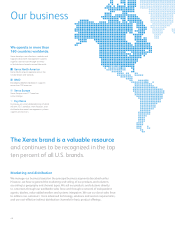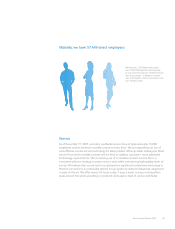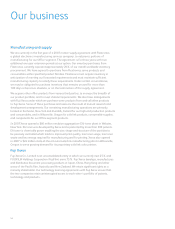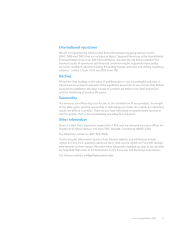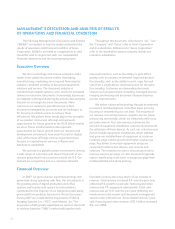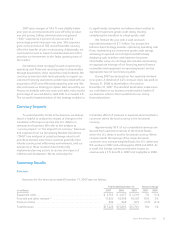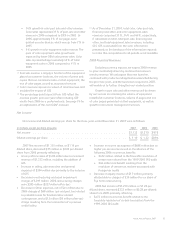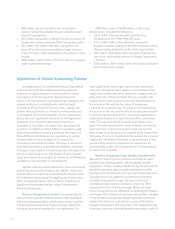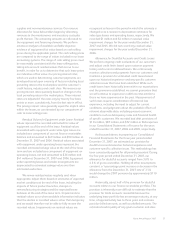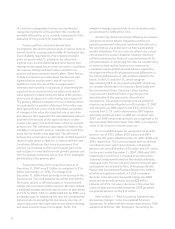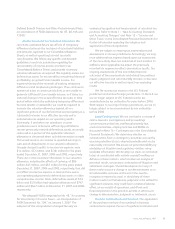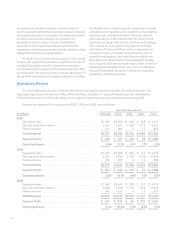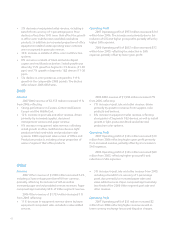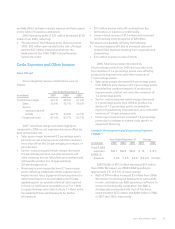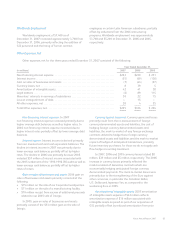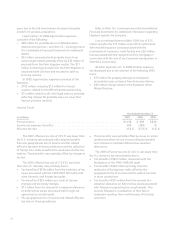Xerox 2007 Annual Report Download - page 58
Download and view the complete annual report
Please find page 58 of the 2007 Xerox annual report below. You can navigate through the pages in the report by either clicking on the pages listed below, or by using the keyword search tool below to find specific information within the annual report.• $68 million (pre-tax and after-tax) for litigation
matters related to probable losses on Brazilian labor-
related contingencies.
• $46 million tax benefit resulting from the resolution of
certain tax matters associated with foreign tax audits.
• $13 million ($9 million after-tax) charge from the
write-off of the unamortized deferred debt issuance
costs as a result of the termination of a previous credit
facility.
• $385 million ($257 million after-tax) restructuring and
asset impairment charges.
2005 Net income of $978 million, or $0.94 per
diluted share, included the following:
• $343 million after-tax benefit related to the
finalization of the 1996-1998 IRS audit.
• $115 million ($84 million after-tax) charge for
litigation matters relating to the MPI arbitration panel
decision and probable losses for other legal matters.
• $93 million ($58 million after-tax) gain related to the
sale of our total equity interest in Integic Corporation
(“Integic”).
• $366 million ($247 million after-tax) restructuring and
asset impairment charges.
Application of Critical Accounting Policies
In preparing our Consolidated Financial Statements
and accounting for the underlying transactions and
balances, we apply various accounting policies. Senior
management has discussed the development and
selection of the critical accounting policies, estimates and
related disclosures, included herein, with the Audit
Committee of the Board of Directors. We consider the
policies discussed below as critical to understanding our
Consolidated Financial Statements, as their application
places the most significant demands on management’s
judgment, since financial reporting results rely on
estimates of the effects of matters that are inherently
uncertain. In instances where different estimates could
have reasonably been used, we disclosed the impact of
these different estimates on our operations. In certain
instances like revenue recognition for leases, the
accounting rules are prescriptive; therefore, it would not
have been possible to reasonably use different estimates.
Changes in assumptions and estimates are reflected in the
period in which they occur. The impact of such changes
could be material to our results of operations and financial
condition in any quarterly or annual period.
Specific risks associated with these critical accounting
policies are discussed throughout the MD&A, where such
policies affect our reported and expected financial results.
For a detailed discussion of the application of these and
other accounting policies, refer to Note 1-Summary of
Significant Accounting Policies, in the Consolidated
Financial Statements.
Revenue Recognition for Leases: Our accounting for
leases involves specific determinations under applicable
lease accounting standards, which often involve complex
and prescriptive provisions. These provisions affect the
timing of revenue recognition for our equipment. If a
lease qualifies as a sales-type capital lease, equipment
revenue is recognized upon delivery or installation of the
equipment as sale revenue as opposed to ratably over the
lease term. The critical elements that we consider with
respect to our lease accounting are the determination of
the economic life and the fair value of equipment,
including the residual value. For purposes of determining
the economic life, we consider the most objective measure
to be the original contract term, since most equipment is
returned by lessees at or near the end of the contracted
term. The economic life of most of our products is five
years since this represents the most frequent contractual
lease term for our principal products and only a small
percentage of our leases are for original terms longer than
five years. There is no significant after-market for our used
equipment. We believe five years is representative of the
period during which the equipment is expected to be
economically usable, with normal service, for the purpose
for which it is intended.
Revenue Recognition Under Bundled Arrangements:
We sell the majority of our products and services under
bundled lease arrangements, which typically include
equipment, service, supplies and financing components for
which the customer pays a single negotiated monthly
fixed price for all elements over the contractual lease term.
Typically these arrangements include an incremental,
variable component for page volumes in excess of
contractual page volume minimums, which are often
expressed in terms of price per page. Revenues under
these arrangements are allocated, considering the relative
fair values of the lease and non-lease deliverables included
in the bundled arrangement, based upon the estimated
relative fair values of each element. Lease deliverables
include maintenance and executory costs, equipment and
financing, while non-lease deliverables generally consist of
56


